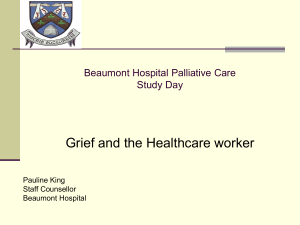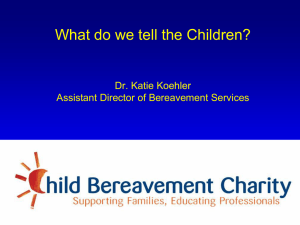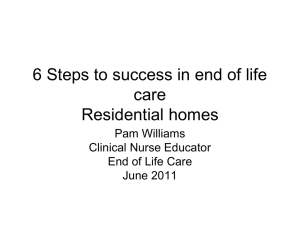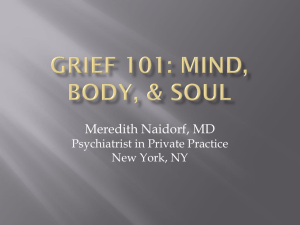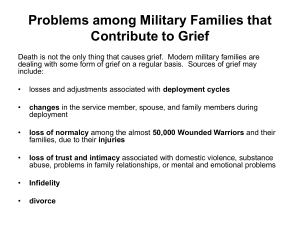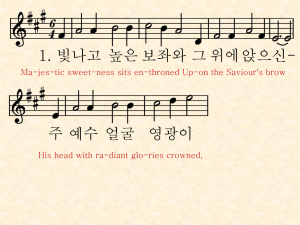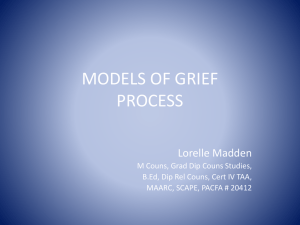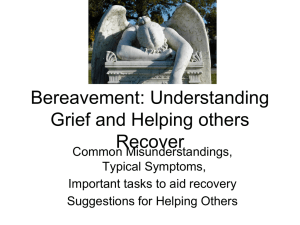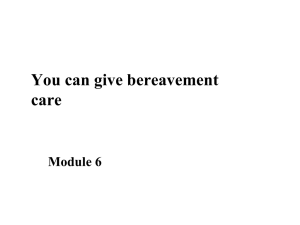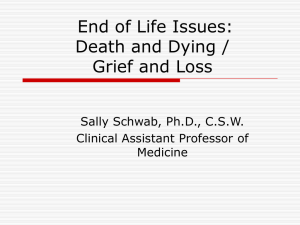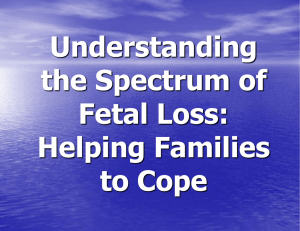What should I do my dissertation on?
advertisement
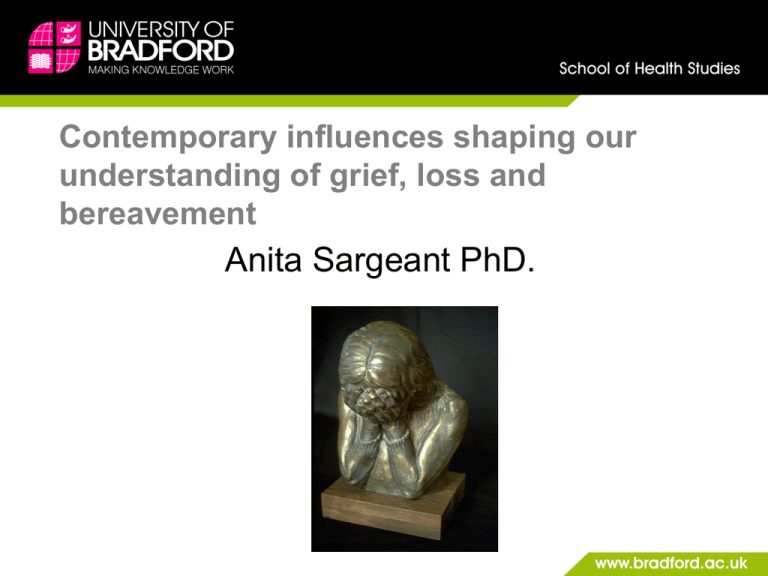
Contemporary influences shaping our understanding of grief, loss and bereavement Anita Sargeant PhD. Anticipatory loss “I want to run away from this all. I don’t want to go through it all again, the sense of helplessness, the drawn-out wait for death, the grief that grinds, through every day even while a loved one is still alive…” Susan Duncan (p336 2006) The Salvation Creek (in Mallon 2008) Edvard Munch 1896: The Sick Child “How people die remains in the memory of those who live on” Dame Cicely Saunders (1918-2005) Changes in our understanding • Foundational theories (1950’s-1990’s) – Attachment theory – Grief work – Stages – Tasks of mourning • Contemporary theories (1990’s-date) – Continuing bonds – Narrative/meaning making – Dual process model – Range of Response to Loss model Psychoanalytical concepts Freud (1917) Mourning and Melancholia • Introduced grief work hypothesis Withdraw from the emotional bond with the deceased to reinvest the emotional energy in the formation of new relationships The influence of Attachment Theory in children • Bowlby (1969, 1973,1980) – Separation anxiety identified – Closeness of relationship increases intensity of the grief • Ainsworth et al (1978) – Avoidant attachment – Secure attachments – Ambivalent attachments Development of stage and phase theories • Parkes (1971,1993,1996) – Quality of attachment in childhood affects bereavement in adulthood – The loss challenges the assumptive world of the bereaved person – Bereavement requires psychosocial transition Development of stage and phase theories Kubler-Ross (1969) On death and Dying • Influential as the first model of its kind – Opened up discussion around death – Easily understandable by healthcare professionals • Emotional processes interpreted by millions as linear in progression when they are cyclical and interchanging Tasks of mourning Worden (1982, 2001) Grief Counselling and Grief Therapy – Provided a practical approach to address the tasks of grieving • • • • Accepting the reality of loss Working through the pain of grief Adjusting to changed environment Emotionally relocating the deceased Criticisms of stage/phase based models • Phase models may have been used prescriptively • tendency for models to be interpreted as linear and prescriptive, leading to perceptions of normal and abnormal • Have not been seen to accept diversity in response – expressions of grief, timing and duration are variable and shaped by culture • The expectation of recovery and a return to normal psychological and social functioning. • Parkes, Kubler-Ross and Worden have modified their theories in light or recent research Coping – The Dual Process Model (Stroebe and Schut 2001) • Defines two types of stressor that the bereaved have to manage: – Loss orientated stressors – Restoration orientated stressors • The dynamic process of grief requires the oscillation between the two stressors Dual Process model Oscillation Loss orientation Restoration orientation Grief work Breaking bonds, intrusion of grief Avoidance of restoration changes Controlled distraction Doing new things Attending to day to day needs Avoidance of grief Range of Response to Loss model (Machin) Conceptualises patterns in grief • Overwhelmed • Balanced/Resilient • Controlled Range of response to loss (Machin p74. 2009) Social Constructs 1 2 3 Perspective on loss An experience of loss is likely to be Overwhelming An experience of loss can be met with Resilience An experience of loss can be Controlled Identification with loss perspective ‘I can not deal with loss and change’ ‘I can face loss and change’ ‘I can control the consequences of loss and change’ Personal narrative account of loss ‘This loss has taken over my life’ ‘Although it is difficult, I know that I have the strength and other people support to help me through this loss’ ‘If I divert from this loss I can manage perfectly well’ Response to other peoples losses ‘I have suffered much more than you have’ ‘I recognise your pain and hope that, like me, you will find the support you need’ ‘Don’t trouble me with your loss. You need to get on with life, as I have’ Common elements of resilience (Machin 2007) • Personal resourcefulness – Qualities such as flexibility, courage and perseverance • Positive life perspective – Optimism, hope, a capacity to make sense of experience and motivation in setting personal goals • Social embeddedness – Availability of support and a capacity to access it ‘The tension between powerlessness and attempts to regain power’ (Machin 2009) • Vulnerability Overwhelming Feelings are powerful and persistent Tension between the Control Overwhelmed feelings Mechanisms for which can not be subdued and subduing distressing the pull of control emotion fail and action becomes difficult Key objective of working with vulnerability and encouraging resilience (Machin 2009 p149) Appraising the possibilities (Realistic use of control) Confronting pain (Facing overwhelmed feelings etc) Resilience Support (Accessing and effective use of social resources) Continuing bonds • Influenced by sociological concepts of constructivism • Maintaining or reinterpreting emotional bonds with the deceased is normal Continuing Bonds - Neimeyer et al (2001, 2006), Klass (2006) • Emphasise adaptive function of retaining bonds with the deceased – Culturally sensetive • Meaning reconstruction – the effort to make meaning of the loss – Complex relearning of connections – Social and communal process When grief gets complicated • Attachments • The nature of the death • Unable to make sense or meaning of the loss • Rumination What shapes our understanding of grief, loss and bereavement? • • • • • Personal development over the lifespan Nature of attachments and relationships Capacity to cope Belief system Culture Thank you
